Assessment of Significant Factors Affecting Frequent Lane-Changing Related to Road Safety: An Integrated Approach of the AHP–BWM Model
Abstract
:1. Introduction
2. Materials and Methods
2.1. Questionnaire Survey
2.2. Lane-Change Model
2.3. Analytic Hierarchy Process (AHP)
2.4. Best–Worst Method (BWM)
2.5. The Proposed AHP–BWM Model
3. Results and Discussion
4. Discussion
5. Conclusions
Author Contributions
Funding
Institutional Review Board Statement
Informed Consent Statement
Data Availability Statement
Acknowledgments
Conflicts of Interest
References
- World Health Organization. Global Status Report on Road Safety 2018: Summary; WHO: Geneva, Switzerland, 2018. [Google Scholar]
- Valette, L. Road Safety: New Statistics Call for Fresh Efforts to Save Lives on EU Roads; European Commission Press: Brussels, Belgium, 2016. [Google Scholar]
- E.U. Commission. Road Safety Facts & Figures; EU Commission: Brussels, Belgium, 2019. [Google Scholar]
- Janstrup, K.H. Road Safety Annual Report 2017; Technical University of Denmark: Lyngby, Denmark, 2017. [Google Scholar]
- Jamal, A.; Zahid, M.; Rahman, M.T.; Al-Ahmadi, H.M.; Almoshaogeh, M.; Farooq, D.; Ahmad, M. Injury Severity Prediction of Traffic Crashes with Ensemble Machine Learning Techniques: A Comparative Study. Int. J. Inj. Control. Saf. Promot. 2021, 1–20. [Google Scholar] [CrossRef]
- Zahid, M.; Chen, Y.; Khan, S.; Jamal, A.; Ijaz, M.; Ahmed, T. Predicting Risky and Aggressive Driving Behavior among Taxi Drivers: Do Spatio-Temporal Attributes Matter? Int. J. Environ. Res. Public Health 2020, 17, 3937. [Google Scholar] [CrossRef]
- NHTSA. National Motor Vehicle Crash Causation Survey: Report to Congress; National Highway Traffic Safety Administration: Washington, DC, USA, 2008.
- Lewin, I. Driver Training: A Perceptual-Motor Skill Approach. Ergonomics 1982, 25, 917–924. [Google Scholar] [CrossRef] [PubMed]
- Rumar, K. The Role of Perceptual and Cognitive Filters in Observed Behavior. Human Behavior and Traffic Safety; Springer: Berlin, Germany, 1985; pp. 151–170. [Google Scholar]
- Rahman, M.T.; Jamal, A.; Al-Ahmadi, H.M. Examining Hotspots of Traffic Collisions and Their Spatial Relationships with Land Use: A GIS-Based GeographicallyWeighted Regression Approach for Dammam, Saudi Arabia. ISPRS Int. J. Geo-Inf. 2020, 9, 540. [Google Scholar] [CrossRef]
- Zahid, M.; Chen, Y.; Jamal, A.; Al-Ahmadi, H.M.; Al-Ofi, A.K. Adopting Machine Learning and Spatial Analysis Techniques for Driver Risk Assessment: Insights from a Case Study. Int. J. Environ. Res. Public Health 2020, 17, 5193. [Google Scholar] [CrossRef]
- Jamal, A.; Umer, W. Exploring the Injury Severity Risk Factors in Fatal Crashes with Neural Network. Int. J. Environ. Res. Public Health 2020, 17, 7466. [Google Scholar] [CrossRef] [PubMed]
- De Oña, J.; de Oña, R.; Eboli, L.; Forciniti, C.; Mazzulla, G. How to Identify the Key Factors That Affect Driver Perception of Accident Risk. A Comparison between Italian and Spanish Driver Behavior. Accid. Anal. Prev. 2014, 73, 225–235. [Google Scholar] [CrossRef] [PubMed]
- Al-Ahmadi, H.M.; Jamal, A.; Ahmed, T.; Rahman, M.T.; Reza, I.; Farooq, D. Calibrating the Highway Safety Manual Predictive Models for Multilane Rural Highway Segments in Saudi Arabia. Arab. J. Sci. Eng. 2021, 1–15. [Google Scholar] [CrossRef]
- Ahmed, T.; Moeinaddini, M.; Almoshaogeh, M.; Jamal, A.; Nawaz, I.; Alharbi, F. A New Pedestrian Crossing Level of Service (PCLOS) Method for Promoting Safe Pedestrian Crossing in Urban Areas. Int. J. Environ. Res. Public Health 2021, 18, 8813. [Google Scholar] [CrossRef] [PubMed]
- Wang, J.; Ding, J.-X.; Shi, Q.; Kühne, R.D. Lane-Changing Behavior and Its Effect on Energy Dissipation Using Full Velocity Difference Model. Int. J. Mod. Phys. C. 2016, 27, 1650013. [Google Scholar] [CrossRef] [Green Version]
- Bernard, K. Accidents Nationwide Associated with Lane-Changing. 2017. Available online: https://www.4injured.com/blog/accidents-lane-changing-risks/ (accessed on 21 August 2020).
- Jamal, A. The Dilemma of Road Safety in the Eastern Provice of Sausi Arabia: Consequences and Prevention Strategies. Int. J. Environ. Res. Public Health 2020, 5, 1–23. [Google Scholar]
- Jamal, A.; Mahmood, T.; Riaz, M.; Al-Ahmadi, H.M. GLM-Based Flexible Monitoring Methods: An Application to Real-Time Highway Safety Surveillance. Symmetry 2021, 13, 362. [Google Scholar] [CrossRef]
- Kesting, A.; Treiber, M.; Helbing, D. General Lane-Changing Model MOBIL for Car-Following Models. Transp. Res. Rec. 2007, 1999, 86–94. [Google Scholar] [CrossRef] [Green Version]
- Wang, M.; Hoogendoorn, S.P.; Daamen, W.; van Arem, B.; Happee, R. Game Theoretic Approach for Predictive Lane-Changing and Car-Following Control. Transp. Res. Part C Emerg. Technol. 2015, 58, 73–92. [Google Scholar] [CrossRef]
- Wang, X.; Zhang, J.; Liu, Y.; Yunyun, W.; Wang, F.; Wang, J. The Drivers’ Lane Selection Model Based on Mixed Fuzzy Many-Person Multi-Objective Non-Cooperative Game. J. Intell. Fuzzy Syst. 2017, 32, 4235–4246. [Google Scholar] [CrossRef]
- Yu, H.; Tseng, H.E.; Langari, R. A Human-like Game Theory-Based Controller for Automatic Lane Changing. Transp. Res. Part C Emerg. Technol. 2018, 88, 140–158. [Google Scholar] [CrossRef]
- Zheng, J.; Suzuki, K.; Fujita, M. Predicting Driver’s Lane-Changing Decisions Using a Neural Network Model. Simul. Model. Pract. Theory 2014, 42, 73–83. [Google Scholar] [CrossRef]
- Li, K.; Wang, X.; Xu, Y.; Wang, J. Lane Changing Intention Recognition Based on Speech Recognition Models. Transp. Res. Part C Emerg. Technol. 2016, 69, 497–514. [Google Scholar] [CrossRef]
- Farooq, D.; Juhasz, J. Simulation-Based Analysis of the Effect of Significant Traffic Parameters on Lane Changing for Driving Logic “Cautious” on a Freeway. Sustainability 2019, 11, 5976. [Google Scholar] [CrossRef] [Green Version]
- Long, X.; Zhang, L.; Liu, S.; Wang, J. Research on Decision-Making Behavior of Discretionary Lane-Changing Based on Cumulative Prospect Theory. J. Adv. Transp. 2020, 2020, 1291342. [Google Scholar] [CrossRef]
- Li, A.; Sun, L.; Zhan, W.; Tomizuka, M. Multiple Criteria Decision-Making for Lane-Change Model. Available online: https://arxiv.org/abs/1910.10142 (accessed on 28 July 2021).
- Duleba, S.; Moslem, S. Examining Pareto Optimality in Analytic Hierarchy Process on Real Data: An Application in Public Transport Service Development. Expert Syst. Appl. 2019, 116, 21–30. [Google Scholar] [CrossRef]
- Pourghasemi, H.R.; Pradhan, B.; Gokceoglu, C. Application of Fuzzy Logic and Analytical Hierarchy Process (AHP) to Landslide Susceptibility Mapping at Haraz Watershed, Iran. Nat. Hazards 2012, 63, 965–996. [Google Scholar] [CrossRef]
- Ghorbanzadeh, O.; Feizizadeh, B.; Blaschke, T. An Interval Matrix Method Used to Optimize the Decision Matrix in AHP Technique for Land Subsidence Susceptibility Mapping. Environ. Earth Sci. 2018, 77, 1–19. [Google Scholar] [CrossRef]
- Moslem, S.; Gul, M.; Farooq, D.; Celik, E.; Ghorbanzadeh, O.; Blaschke, T. An Integrated Approach of Best-Worst Method (Bwm) and Triangular Fuzzy Sets for Evaluating Driver Behavior Factors Related to Road Safety. Mathematics 2020, 8, 414. [Google Scholar] [CrossRef] [Green Version]
- Ghoushchi, S.J.; Yousefi, S.; Khazaeili, M. An Extended FMEA Approach Based on the Z-MOORA and Fuzzy BWM for Prioritization of Failures. Appl. Soft Comput. 2019, 81, 105505. [Google Scholar] [CrossRef]
- Chang, T.-W.; Lo, H.-W.; Chen, K.-Y.; Liou, J.J. A Novel FMEA Model Based on Rough BWM and Rough TOPSIS-AL for Risk. Assessment. Math. 2019, 7, 874. [Google Scholar] [CrossRef] [Green Version]
- Lo, H.-W.; Liou, J.J. A Novel Multiple-Criteria Decision-Making-Based FMEA Model for Risk Assessment. Appl. Soft Comput. 2018, 73, 684–696. [Google Scholar] [CrossRef]
- Nie, R.; Tian, Z.; Wang, X.; Wang, J.; Wang, T. Risk Evaluation by FMEA of Supercritical Water Gasification System Using Multi-Granular Linguistic Distribution Assessment. Knowl.-Based Syst. 2018, 162, 185–201. [Google Scholar] [CrossRef]
- Rezaei, J. Best-Worst Multi-Criteria Decision-Making Method. Omega 2015, 53, 49–57. [Google Scholar] [CrossRef]
- Rezaei, J. Best-Worst Multi-Criteria Decision-Making Method: Some Properties and a Linear Model. Omega 2016, 64, 126–130. [Google Scholar] [CrossRef]
- Shekhovtsov, A.; Rehman, N.; Faizi, S.; Salabun, W. On the Analytic Hierarchy Process Structure in Group Decision-Making Using Incomplete Fuzzy Information with Applications. Symmetry 2021, 13, 609. [Google Scholar]
- Faizi, S.; Sałabun, W.; Nawaz, S.; Rehman, A.; Wątróbski, J. Best-Worst Method and Hamacher Aggregation Operations for Intuitionistic 2-Tuple Linguistic Sets. Expert Syst. Appl. 2021, 181, 115088. [Google Scholar] [CrossRef]
- Moslem, S.; Farooq, D.; Karasan, A. Evaluating driver behavior criteria connected to road safety by considering 2-dimensional uncertain linguistic data. In Proceedings of the International Conference on Intelligent and Fuzzy Systems, Izmir, Turkey, 24–26 August 2021; Springer: Berlin, Germany, 2021; pp. 388–399. [Google Scholar]
- Shawky, M. Factors Affecting Lane Change Crashes. IATSS Res. 2020, 44, 155–161. [Google Scholar] [CrossRef]
- Almoshaogeh, M.; Abdulrehman, R.; Haider, H.; Alharbi, F.; Jamal, A.; Alarifi, S.; Shafiquzzaman, M. Traffic Accident Risk Assessment Framework for Qassim, Saudi Arabia: Evaluating the Impact of Speed Cameras. Appl. Sci. 2021, 11, 6682. [Google Scholar] [CrossRef]
- Farooq, D.; Moslem, S.; Duleba, S. Evaluation of Driver Behavior Criteria for Evolution of Sustainable Traffic Safety. Sustainability 2019, 11, 3142. [Google Scholar] [CrossRef] [Green Version]
- Bener, A.; Al Maadid, M.G.; Özkan, T.; Al-Bast, D.A.; Diyab, K.N.; Lajunen, T. The Impact of Four-Wheel Drive on Risky Driver Behaviours and Road Traffic Accidents. Transp. Res. Part F Traffic Psychol. Behav. 2008, 11, 324–333. [Google Scholar] [CrossRef]
- Wåhlberg, A.; Dorn, L.; Kline, T. The Manchester Driver Behaviour Questionnaire as a Predictor of Road Traffic Accidents. Theor. Issues Ergon. Sci. 2011, 12, 66–86. [Google Scholar] [CrossRef] [Green Version]
- Driving Errors, Driving Violations and Accident Involvement. Google Scholar. Available online: https://scholar.google.com/scholar?hl=en&as_sdt=0%2C5&q=Driving+errors%2C+driving+violations+and+accident+involvement&btnG= (accessed on 25 August 2021).
- Reason, J.; Manstead, A.; Stradling, S.; Baxter, J.; Campbell, K. Errors and Violations on the Roads: A Real Distinction? Ergonomics 1990, 33, 1315–1332. [Google Scholar] [CrossRef]
- Solomon, M. Groupthink versus The Wisdom of Crowds: The Social Epistemology of Deliberation and Dissent. South. J. Philos. 2006, 44, 28–42. [Google Scholar] [CrossRef]
- National Highway Traffic Safety Administration. A Comprehensive Examination of Naturalistic Lane-Change; National Highway Traffic Safety Administration: Washington, DC, USA, 2004.
- Ghasemi Noughabi, M.; Sadeghi, A.; Mohammadzadeh Moghaddam, A.; Jalili Qazizadeh, M. Fatigue Risk Management: Assessing and Ranking the Factors Affecting the Degree of Fatigue and Sleepiness of Heavy-Vehicle Drivers Using TOPSIS and Statistical Analyses. Iran. J. Sci. Technol. Trans. Civ. Eng. 2020, 44, 1345–1357. [Google Scholar] [CrossRef]
- Fitch, G.M.; Lee, S.E.; Klauer, S.; Hankey, J.; Sudweeks, J. Analysis of Lane-Change Crashes and Near-Crashes” Department of Transportation; National Highway Traffic Safety Administration: Washington, DC, USA, 2009; pp. 1–232.
- Park, H.; Oh, C.; Moon, J.; Kim, S. Development of a Lane Change Risk Index Using Vehicle Trajectory Data. Accid. Anal. Prev. 2018, 110, 1–8. [Google Scholar] [CrossRef]
- Zhao, D.; Peng, H.; Nobukawa, K.; Bao, S.; David, L.; Pan, C.S. Analysis of Mandatory and Discretionary Lane Change Behaviors for Heavy Trucks. Available online: https://arxiv.org/abs/1707.09411 (accessed on 9 August 2021).
- Subramanian, N.; Ramanathan, R. A Review of Applications of Analytic Hierarchy Process in Operations Management. Int. J. Prod. Econ. 2012, 138, 215–241. [Google Scholar] [CrossRef]
- Krmac, E.; Djordjević, B. An Evaluation of Train Control Information Systems for Sustainable Railway Using the Analytic Hierarchy Process (AHP) Model. Eur. Transp. Res. Rev. 2017, 9, 35. [Google Scholar] [CrossRef] [Green Version]
- Moslem, S.; Ghorbanzadeh, O.; Blaschke, T.; Duleba, S. Analysing Stakeholder Consensus for a Sustainable Transport Development Decision by the Fuzzy AHP and Interval AHP. Sustainability 2019, 11, 3271. [Google Scholar] [CrossRef] [Green Version]
- Darko, A.; Chan, A.P.C.; Ameyaw, E.E.; Owusu, E.K.; Pärn, E.; Edwards, D.J. Review of Application of Analytic Hierarchy Process (AHP) in Construction. Int. J. Constr. Manag. 2019, 19, 436–452. [Google Scholar] [CrossRef]
- Saaty, T.L. A Scaling Method for Priorities in Hierarchical Structures. J. Math. Psychol. 1977, 15, 234–281. [Google Scholar] [CrossRef]
- Rezaei, J.; Kothadiya, O.; Tavasszy, L.; Kroesen, M. Quality Assessment of Airline Baggage Handling Systems Using SERVQUAL and BWM. Tour. Manag. 2018, 66, 85–93. [Google Scholar] [CrossRef]
- Mi, X.; Tang, M.; Liao, H.; Shen, W.; Lev, B. The State-of-the-Art Survey on Integrations and Applications of the Best Worst Method in Decision Making: Why, What, What for and What’s Next? Omega 2019, 87, 205–225. [Google Scholar] [CrossRef]
- Liang, F.; Brunelli, M.; Rezaei, J. Consistency Issues in the Best Worst Method: Measurements and Thresholds. Omega 2020, 96, 102175. [Google Scholar] [CrossRef]
- Moridpour, S.; Rose, G.; Sarvi, M. Effect of Surrounding Traffic Characteristics on Lane Changing Behavior. J. Transp. Eng. 2010, 136, 973–985. [Google Scholar] [CrossRef]
- Li, X.; Sun, J.-Q. Studies of Vehicle Lane-Changing Dynamics and Its Effect on Traffic Efficiency, Safety and Environmental Impact. Phys. A Stat. Mech. Its Appl. 2017, 467, 41–58. [Google Scholar] [CrossRef]
- Bella, F. How Traffic Conditions Affect Driver Behavior in Passing Meneuver. Adv. Transp. Stud. Int. J. 2011, 113–126. [Google Scholar]
- Mizanur, R.M.; Nakamura, F. A study on passing-overtaking characteristics and level of service of heterogeneous traffic flow. J. East. Asia Soc. Transp. Stud. 2005, 6, 1471–1483. [Google Scholar]
- Danish, F.; Juhasz, J. An Investigation of Speed Variance Effect on Lane-Changing for Driving Logic “Cautious” on Highways. Adv. Transp. Stud. Int. J. 2020, 51, 109–120. [Google Scholar]
- Weng, J.; Meng, Q. Effects of Environment, Vehicle and Driver Characteristics on Risky Driving Behavior at Work Zones. Saf. Sci. 2012, 50, 1034–1042. [Google Scholar] [CrossRef]
- Yang, L.; Li, X.; Guan, W.; Zhang, H.M.; Fan, L. Effect of Traffic Density on Drivers’ Lane Change and Overtaking Maneuvers in Freeway Situation—A Driving Simulator–Based Study. Traffic Inj. Prev. 2018, 19, 594–600. [Google Scholar] [CrossRef] [PubMed] [Green Version]
- Lee, J.; Park, B.B. Determining Lane Use Distributions Using Basic Freeway Segment Density Measures. J. Transp. Eng. 2012, 138, 210–217. [Google Scholar] [CrossRef]
- Sałabun, W.; Urbaniak, K. A New Coefficient of Rankings Similarity in Decision-Making Problems. In Proceedings of the International Conference on Computational Science, Amsterdam, The Netherlands, 3–5 June 2020; Springer: Berlin, Germany, 2020; pp. 632–645. [Google Scholar]
- Ding, T.; Li, X.; Zheng, L.; Hao, Z. Research on Safety Lane Change Warning Method Based on Potential Angle Collision Point. J. Adv. Transp. 2019, 2019, 1281425. [Google Scholar] [CrossRef]
- Lu, I.-Y.; Kuo, T.; Lin, T.-S.; Tzeng, G.-H.; Huang, S.-L. Multicriteria Decision Analysis to Develop Effective Sustainable Development Strategies for Enhancing Competitive Advantages: Case of the TFT-LCD Industry in Taiwan. Sustainability 2016, 8, 646. [Google Scholar] [CrossRef] [Green Version]
- Huang, K.-W.; Huang, J.-H.; Tzeng, G.-H. New Hybrid Multiple Attribute Decision-Making Model for Improving Competence Sets: Enhancing a Company’s Core Competitiveness. Sustainability 2016, 8, 175. [Google Scholar] [CrossRef] [Green Version]
- Liou, J.J.; Tsai, C.-Y.; Lin, R.-H.; Tzeng, G.-H. A Modified VIKOR Multiple-Criteria Decision Method for Improving Domestic Airlines Service Quality. J. Air Transp. Manag. 2011, 17, 57–61. [Google Scholar] [CrossRef]
- Chang, D.-S.; Chen, S.-H.; Hsu, C.-W.; Hu, A.H.; Tzeng, G.-H. Evaluation Framework for Alternative Fuel Vehicles: Sustainable Development Perspective. Sustainability 2015, 7, 11570–11594. [Google Scholar] [CrossRef] [Green Version]
- Dragan Krstić, M.; Radoman Tadić, S.; Brnjac, N.; Zečević, S. Intermodal Terminal Handling Equipment Selection Using a Fuzzy Multi-Criteria Decision-Making Model. Promet-Traffic Transp. 2019, 31, 89–100. [Google Scholar] [CrossRef]
- Memiş, S.; Demir, E.; Karamaşa, Ç.; Korucuk, S. Prioritization of Road Transportation Risks: An Application in Giresun Province. Oper. Res. Eng. Sci.Theory Appl. 2020, 3, 111–126. [Google Scholar] [CrossRef]
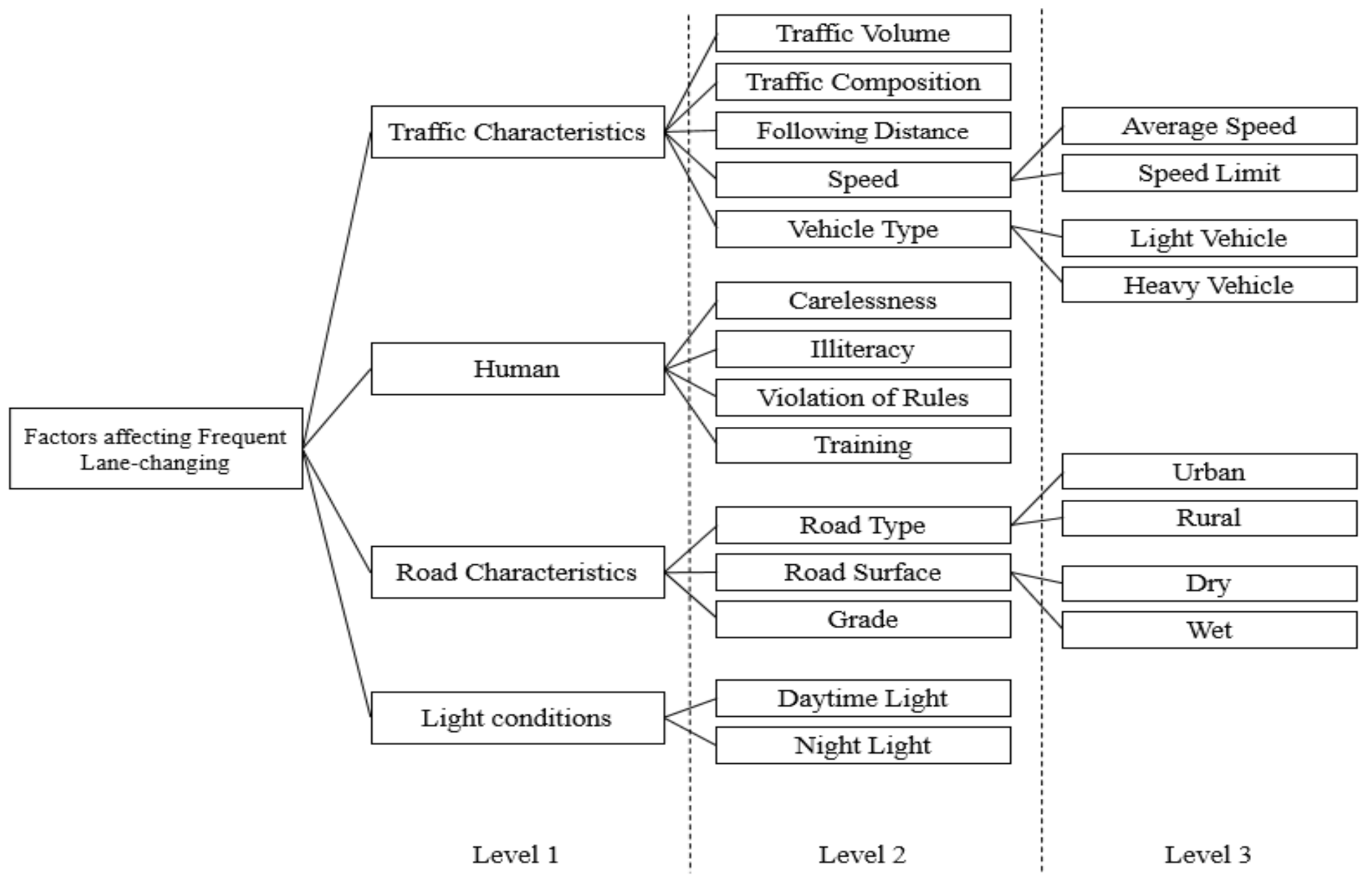
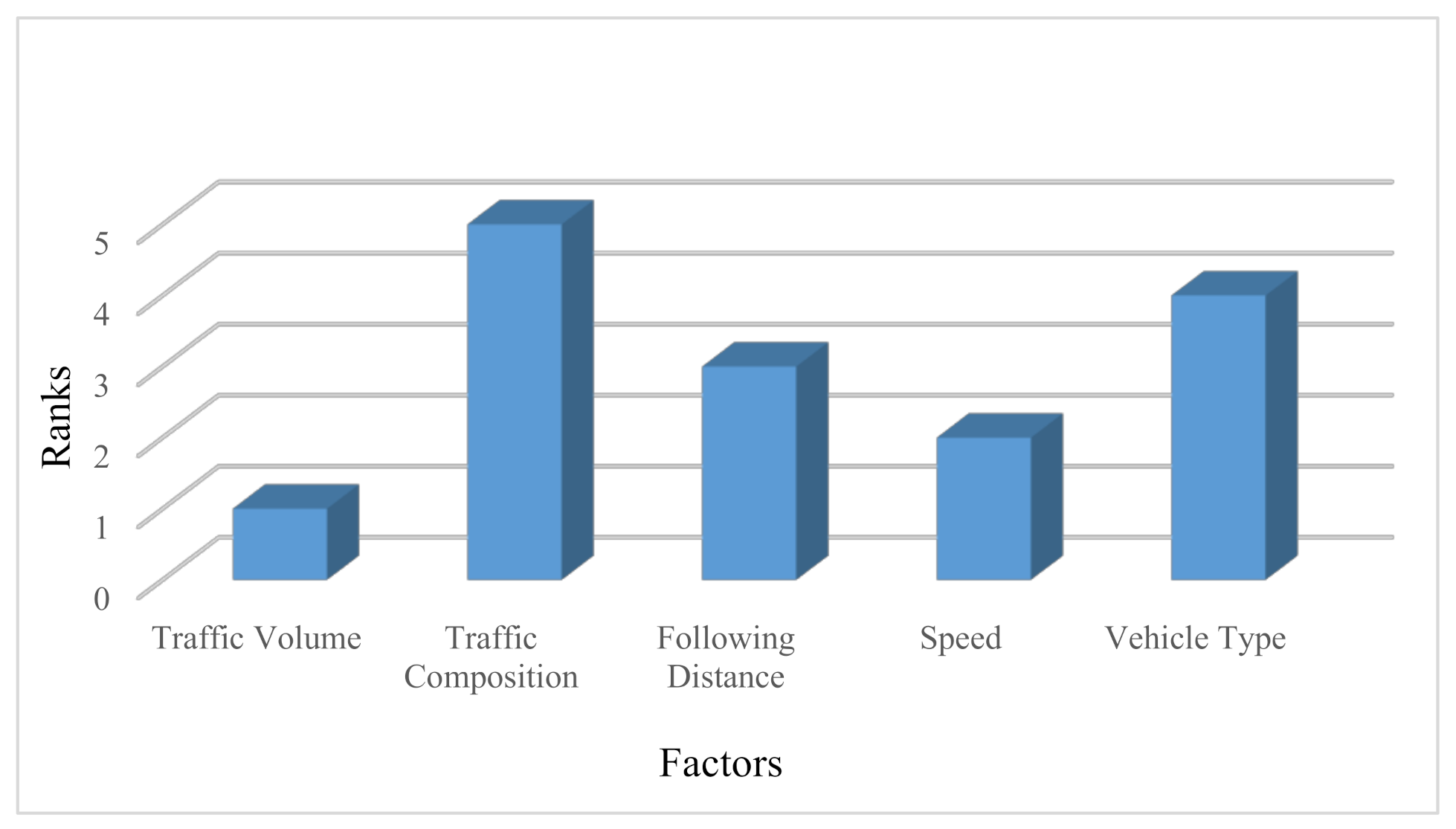
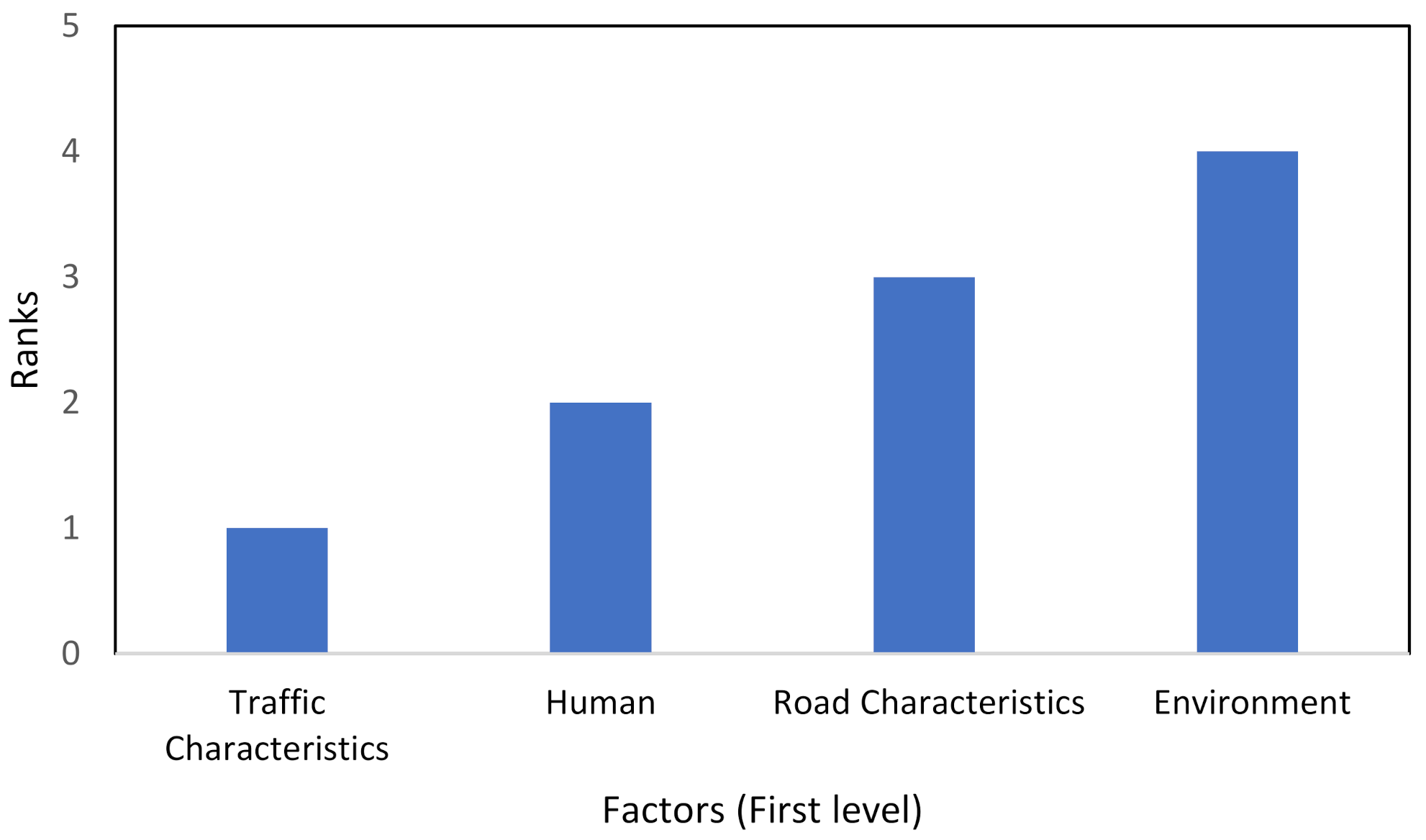
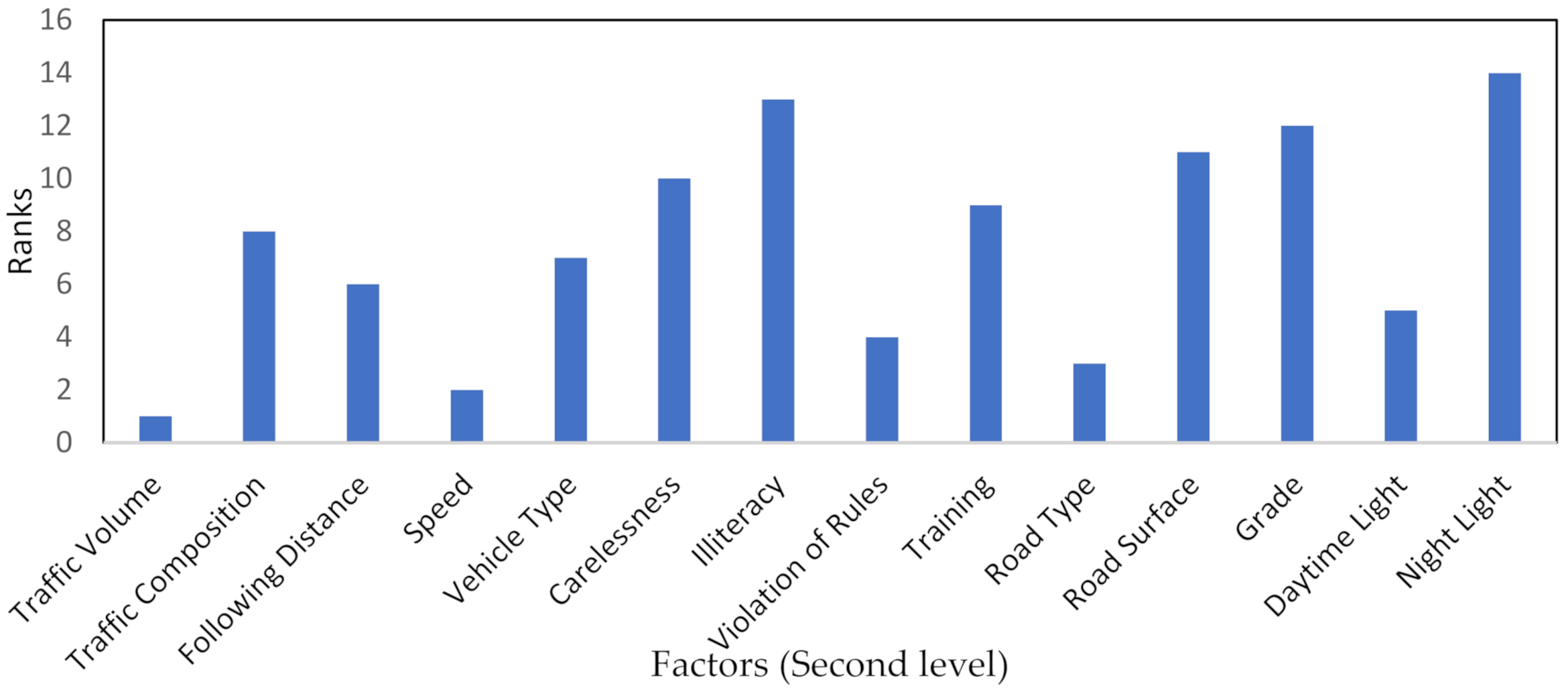
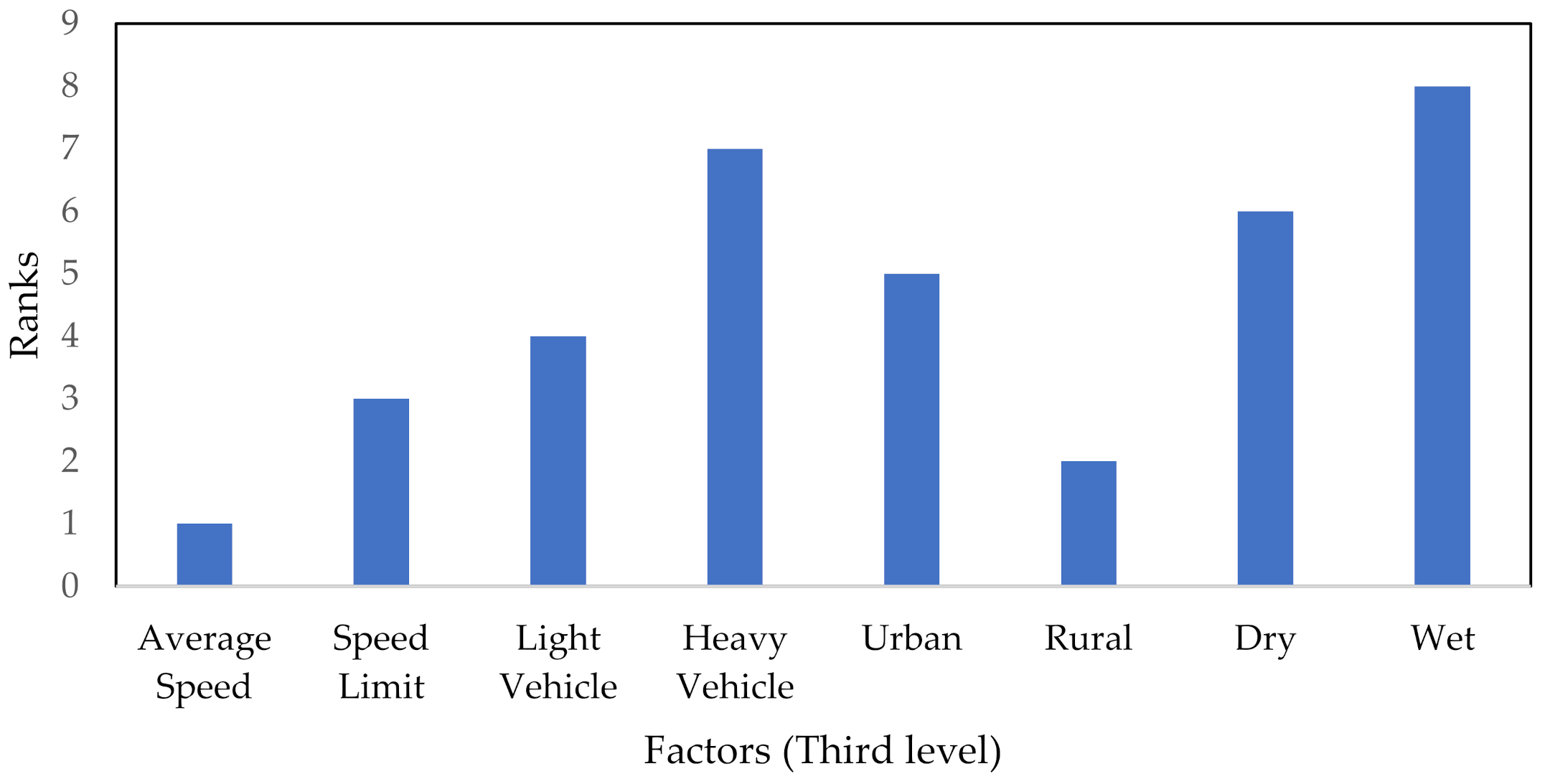
| Variables | Frequency | Percentage (%) |
|---|---|---|
| N | 49 | 100 |
| Age (years) | ||
| 18–30 | 17 | 35 |
| 31–50 | 22 | 45 |
| 51 above | 10 | 20 |
| Gender | ||
| Male | 38 | 78 |
| Female | 11 | 22 |
| Duration of driving license (years) | ||
| 01–05 | 13 | 27 |
| 06–15 | 28 | 57 |
| 16–30 | 8 | 16 |
| Education level | ||
| Bachelor’s degree | 20 | 41 |
| MSc/PhD | 29 | 59 |
| Working status | ||
| Student | 22 | 45 |
| Job | 27 | 55 |
| Compare the Importance of Specified Factors with Respect to Frequent Lane-Changing | ||||||||||||||||||
|---|---|---|---|---|---|---|---|---|---|---|---|---|---|---|---|---|---|---|
| Traffic Characteristics | 9 | 8 | 7 | 6 | 5 | 4 | 3 | 2 | 1 | 2 | 3 | 4 | 5 | 6 | 7 | 8 | 9 | Human |
| Traffic Characteristics | 9 | 8 | 7 | 6 | 5 | 4 | 3 | 2 | 1 | 2 | 3 | 4 | 5 | 6 | 7 | 8 | 9 | Road Characteristics |
| Traffic Characteristics | 9 | 8 | 7 | 6 | 5 | 4 | 3 | 2 | 1 | 2 | 3 | 4 | 5 | 6 | 7 | 8 | 9 | Light conditions |
| Human | 9 | 8 | 7 | 6 | 5 | 4 | 3 | 2 | 1 | 2 | 3 | 4 | 5 | 6 | 7 | 8 | 9 | Road Characteristics |
| Human | 9 | 8 | 7 | 6 | 5 | 4 | 3 | 2 | 1 | 2 | 3 | 4 | 5 | 6 | 7 | 8 | 9 | Light conditions |
| Road Characteristics | 9 | 8 | 7 | 6 | 5 | 4 | 3 | 2 | 1 | 2 | 3 | 4 | 5 | 6 | 7 | 8 | 9 | Light conditions |
| Please, Select the Most Important Factor from Specified “Traffic Characteristics” Factors and Compare It with Other Factors by Considering Lane-Changing Phenomenon Using a (1–9) Judgment Scale | |||||
|---|---|---|---|---|---|
| Traffic Characteristics | Traffic Volume | Traffic Composition | Following Distance | Speed | Vehicle Type |
| Most important factor: (………….…) | |||||
| Less important factor: (………….…) | |||||
| Numerical Judgment Scale | Verbal Judgment Scale (Definition) |
|---|---|
| 1 | Equal significance |
| 2 | Weak importance |
| 3 | Moderate importance |
| 4 | More than moderate importance |
| 5 | Strong significance |
| 6 | More than strong significance |
| 7 | Very strong importance |
| 8 | Extremely important |
| 9 | Absolute significance |
| n | 3 | 4 | 5 | 6 | 7 | 8 | 9 | 10 |
|---|---|---|---|---|---|---|---|---|
| RI | 0.58 | 0.9 | 1.12 | 1.24 | 1.32 | 1.41 | 1.45 | 1.49 |
| Scale | Factors | ||||||
|---|---|---|---|---|---|---|---|
| 3 | 4 | 5 | 6 | 7 | 8 | 9 | |
| 3 | 0.1667 | 0.1667 | 0.1667 | 0.1667 | 0.1667 | 0.1667 | 0.1667 |
| 4 | 0.1121 | 0.1529 | 0.1898 | 0.2206 | 0.2577 | 0.2577 | 0.2683 |
| 5 | 0.1354 | 0.1994 | 0.2306 | 0.2546 | 0.2716 | 0.2844 | 0.2960 |
| 6 | 0.1330 | 0.1990 | 0.2643 | 0.3044 | 0.3144 | 0.3221 | 0.3262 |
| 7 | 0.1294 | 0.2457 | 0.2819 | 0.3029 | 0.3144 | 0.3251 | 0.3403 |
| 8 | 0.1309 | 0.2521 | 0.3154 | 0.3108 | 0.3408 | 0.3620 | 0.3657 |
| 9 | 0.1359 | 0.2681 | 0.3337 | 0.3517 | 0.3517 | 0.3620 | 0.3662 |
| Level 1 | Level 2 | Level 3 | |||
|---|---|---|---|---|---|
| Factor | Weight | Factor | Weight | Factor | Weight |
| Main factors | Traffic characteristics | Speed | |||
| Traffic characteristics | 0.5148 | Traffic volume | 0.3440 | Average speed | 0.5148 |
| Human | 0.2134 | Traffic composition | 0.1075 | Speed limit | 0.4852 |
| Road characteristics | 0.1834 | Following distance | 0.1381 | Vehicle type | |
| Light conditions | 0.0884 | Speed | 0.2954 | Light vehicle | 0.7068 |
| Vehicle type | 0.1150 | Heavy vehicle | 0.2932 | ||
| Human | Road type | ||||
| Carelessness | 0.2475 | Urban | 0.3026 | ||
| Illiteracy | 0.1099 | Rural | 0.6974 | ||
| Violation of rules | 0.3859 | Road surface | |||
| Training | 0.2566 | Dry | 0.7199 | ||
| Road characteristics | Wet | 0.2801 | |||
| Road type | 0.5969 | ||||
| Road surface | 0.2203 | ||||
| Grade | 0.1828 | ||||
| Light conditions | |||||
| Daytime light | 0.8396 | ||||
| Night light | 0.1604 | ||||
| Factor | Final Weight of AHP–BWM | Rank | Final Weight of AHP Approach | Rank |
|---|---|---|---|---|
| Traffic volume | 0.1771 | 1 | 0.1819 | 1 |
| Traffic composition | 0.0554 | 8 | 0.0578 | 8 |
| Following distance | 0.0711 | 6 | 0.0690 | 6 |
| Speed | 0.1521 | 2 | 0.1425 | 2 |
| Vehicle type | 0.0592 | 7 | 0.0635 | 7 |
| Carelessness | 0.0528 | 10 | 0.0528 | 10 |
| Illiteracy | 0.0235 | 13 | 0.0235 | 13 |
| Violation of rules | 0.0824 | 4 | 0.0824 | 4 |
| Training | 0.0548 | 9 | 0.0548 | 9 |
| Road type | 0.1095 | 3 | 0.1095 | 3 |
| Road surface | 0.0404 | 11 | 0.0404 | 11 |
| Grade | 0.0335 | 12 | 0.0335 | 12 |
| Daytime light | 0.0742 | 5 | 0.0742 | 5 |
| Night light | 0.0142 | 14 | 0.0142 | 14 |
| Factor | Final Weight of AHP–BWM | Rank | Final Weight of AHP Approach | Rank |
|---|---|---|---|---|
| Average speed | 0.0783 | 1 | 0.0734 | 2 |
| Speed limit | 0.0738 | 3 | 0.0691 | 3 |
| Light vehicle | 0.0418 | 4 | 0.0449 | 4 |
| Heavy vehicle | 0.0174 | 7 | 0.0186 | 7 |
| Urban | 0.0331 | 5 | 0.0331 | 5 |
| Rural | 0.0764 | 2 | 0.0764 | 1 |
| Dry | 0.0291 | 6 | 0.0291 | 6 |
| Wet | 0.0113 | 8 | 0.0113 | 8 |
Publisher’s Note: MDPI stays neutral with regard to jurisdictional claims in published maps and institutional affiliations. |
© 2021 by the authors. Licensee MDPI, Basel, Switzerland. This article is an open access article distributed under the terms and conditions of the Creative Commons Attribution (CC BY) license (https://creativecommons.org/licenses/by/4.0/).
Share and Cite
Farooq, D.; Moslem, S.; Jamal, A.; Butt, F.M.; Almarhabi, Y.; Faisal Tufail, R.; Almoshaogeh, M. Assessment of Significant Factors Affecting Frequent Lane-Changing Related to Road Safety: An Integrated Approach of the AHP–BWM Model. Int. J. Environ. Res. Public Health 2021, 18, 10628. https://doi.org/10.3390/ijerph182010628
Farooq D, Moslem S, Jamal A, Butt FM, Almarhabi Y, Faisal Tufail R, Almoshaogeh M. Assessment of Significant Factors Affecting Frequent Lane-Changing Related to Road Safety: An Integrated Approach of the AHP–BWM Model. International Journal of Environmental Research and Public Health. 2021; 18(20):10628. https://doi.org/10.3390/ijerph182010628
Chicago/Turabian StyleFarooq, Danish, Sarbast Moslem, Arshad Jamal, Farhan Muhammad Butt, Yahya Almarhabi, Rana Faisal Tufail, and Meshal Almoshaogeh. 2021. "Assessment of Significant Factors Affecting Frequent Lane-Changing Related to Road Safety: An Integrated Approach of the AHP–BWM Model" International Journal of Environmental Research and Public Health 18, no. 20: 10628. https://doi.org/10.3390/ijerph182010628
APA StyleFarooq, D., Moslem, S., Jamal, A., Butt, F. M., Almarhabi, Y., Faisal Tufail, R., & Almoshaogeh, M. (2021). Assessment of Significant Factors Affecting Frequent Lane-Changing Related to Road Safety: An Integrated Approach of the AHP–BWM Model. International Journal of Environmental Research and Public Health, 18(20), 10628. https://doi.org/10.3390/ijerph182010628









